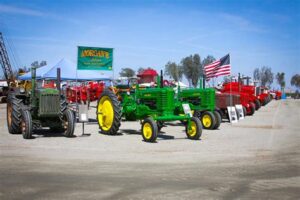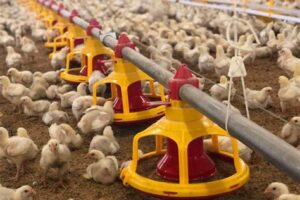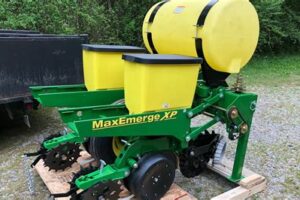Table of Contents
During the 1930s, the Dust Bowl catastrophe severely damaged topsoil and farming equipment in the United States. Prolonged drought and poor land management practices led to massive dust storms that stripped away fertile topsoil layers, making it difficult for farmers to grow crops. The swirling dust particles caused significant damage to farming machinery, clogging engines, and rendering equipment unusable. This environmental disaster had long-lasting impacts on agriculture and highlighted the need for sustainable farming practices.
The 1930s marked a dark and devastating period in American history, particularly for the agricultural sector. As the Great Depression gripped the nation, farmers were already struggling to make ends meet. However, a catastrophic event, known as the Dust Bowl, exacerbated their woes and left an indelible mark on the landscape. The combination of severe drought, poor farming practices, and strong winds led to the destruction of vast stretches of topsoil, leaving fields barren and unusable. In addition to the decimation of fertile land, farming equipment also suffered tremendously, succumbing to the relentless assault of the swirling dust storms. It is crucial to understand the factors that contributed to the damage inflicted upon both topsoil and farming equipment during this tumultuous era, shedding light on the far-reaching consequences of an environmental disaster that forever altered the face of American agriculture.
The Dust Bowl: Unprecedented Environmental Disaster
During the 1930s, the United States experienced one of the most devastating environmental disasters in its history – the Dust Bowl. This period of severe dust storms and drought primarily affected the Great Plains region, leading to significant damage to topsoil and farming equipment. The combination of poor farming practices and natural weather patterns resulted in widespread erosion, leaving farmers and their equipment vulnerable to the destructive forces of the elements.
The Impact of Wind Erosion on Topsoil
One of the main factors that damaged topsoil during the 1930s was wind erosion. As drought conditions prevailed and vegetation cover diminished, the loose topsoil became susceptible to the forceful winds typical of the Great Plains. These winds would pick up the fine particles of soil and carry them away, leading to massive soil loss. The exposed subsoil was less fertile and lacked the essential nutrients necessary for successful crop growth. This erosion significantly hampered agricultural productivity and caused long-term damage to the land.
Ineffective Farming Techniques
Poor farming techniques also contributed to the destruction of topsoil and farming equipment during the 1930s. Many farmers in the Great Plains practiced extensive plowing, which involved turning over the soil to expose fresh layers for planting. However, this method left the soil vulnerable to erosion as it removed protective vegetation cover and disrupted the natural structure of the land. Additionally, the lack of crop rotation and failure to implement proper soil conservation practices further exacerbated the soil degradation problem.
The Destruction of Farming Equipment
The relentless dust storms of the 1930s not only damaged topsoil but also wreaked havoc on farming equipment. The abrasive nature of the blowing dust particles resulted in significant wear and tear on agricultural machinery. The fine dust particles infiltrated the machines’ intricate mechanical components, causing friction, clogging, and accelerated deterioration. Maintaining and repairing equipment became increasingly challenging as the dust storms persisted and engulfed the farming communities.
Economic Consequences of Topsoil and Equipment Damage
The damage inflicted upon topsoil and farming equipment had severe economic ramifications during the 1930s. As topsoil eroded and fertility declined, crop yields plummeted, leading to widespread agricultural losses. The destruction of farming equipment further compounded the financial burden on already-struggling farmers. With reduced productivity and increased maintenance costs, many farmers were unable to sustain their livelihoods and faced immense financial hardships.
Addressing the Crisis: Soil Conservation Efforts
Recognizing the urgency of the situation, government agencies, such as the Soil Conservation Service, implemented various initiatives to combat the topsoil erosion crisis and protect farming equipment. These efforts aimed to educate farmers on proper soil conservation techniques, including contour plowing, strip cropping, and terracing. By adopting these practices, farmers could reduce water runoff, control erosion, and enhance the overall health of the soil. Additionally, programs were introduced to provide financial assistance for the repair and replacement of damaged farming equipment.
The Legacy of the Dust Bowl
The devastating effects of the Dust Bowl and its impact on topsoil and farming equipment left a lasting legacy. The environmental catastrophe served as a wake-up call, prompting significant changes in agricultural practices and policies. The adoption of soil conservation measures became more widespread, leading to improved land management techniques. Additionally, the creation of programs like the Civilian Conservation Corps provided employment opportunities for many affected farmers while also aiding in land restoration efforts.
Farming Today: Learning from the Past
Today, the lessons learned from the topsoil and farming equipment damage during the 1930s Dust Bowl have greatly influenced modern agricultural practices. Farmers now prioritize sustainable farming methods, emphasizing soil conservation, crop rotation, and responsible use of machinery. The advancements in technology and scientific understanding have allowed for more efficient and environmentally conscious farming practices, ensuring that the mistakes of the past are not repeated.
Conclusion
The 1930s Dust Bowl was a time of immense suffering for farmers and the environment alike. The damage inflicted upon topsoil and farming equipment during this period was a result of both natural weather patterns and poor farming practices. However, the lessons learned from this devastating event have shaped modern agriculture, promoting sustainable techniques that prioritize soil conservation and responsible equipment use. By learning from the mistakes of the past, we can ensure a healthier and more resilient agricultural industry for generations to come.
Erosion and Dust Storms: The Devastating Effects on Topsoil
During the 1930s, the phenomenon known as the Dust Bowl caused severe erosion, resulting in the loss of large amounts of topsoil. Continuous plowing, soil depletion, and drought conditions further deteriorated the quality of the top layer of soil, making it vulnerable to wind erosion and dust storms. These dust storms not only eroded the topsoil but also caused significant damage to farming equipment, clogging machinery and reducing their efficiency.
Mechanical Overworking: A Hidden Enemy of Topsoil
Overworking and excessive tilling of the soil, driven by the demand for increased agricultural production, contributed to the degradation of topsoil during the 1930s. Farmers using heavy machinery such as tractors and plows often disrupted the soil structure, leading to increased erosion rates and reduced moisture retention. Consequently, this overworking damaged farming equipment as well, as the heavy usage under harsh conditions put a strain on their mechanical components.
Lack of Crop Rotation: A Vicious Cycle
The failure to implement proper crop rotation practices in the 1930s played a significant role in damaging both topsoil and farming equipment. Continuous production of cash crops like wheat without allowing the land to rest or alternating with cover crops contributed to the depletion of soil nutrients, leaving it vulnerable to erosion. The resulting poor soil health not only affected crop yield but also required the use of heavy machinery to compensate, exerting additional strain on the farming equipment.
Limited Soil Conservation Techniques: Soil Conservation Service to the Rescue
The scarcity of comprehensive soil conservation techniques during the 1930s exacerbated topsoil damage in farming regions. However, the establishment of the Soil Conservation Service under the New Deal brought essential measures into play, aiming to combat soil erosion and promote sustainable farming practices. Efforts such as the construction of terraces, contour plowing, and the implementation of windbreaks helped mitigate topsoil damage and reduced the strain on farming equipment.
Lack of Organic Matter: The Role of Humus in Soil Preservation
The absence of organic matter, particularly humus, in the topsoil impacted its structure and nutrient-holding capacity during the 1930s. The intense plowing and overuse of chemical fertilizers and pesticides disrupted natural soil ecosystems and depleted organic matter levels. This led to weakened soil structure, increased erosion rates, diminished crop yields, and indirectly affected farming equipment maintenance and efficiency due to heightened soil degradation.
Agricultural Practices: Shifting Blame to Poor Farming Techniques
Farmers in the 1930s often relied on reckless agricultural practices that further damaged topsoil and degraded farming equipment. Poor land management techniques, such as improper drainage systems and improper tillage, rendered the soil vulnerable to erosion and depreciation. The consequences of these practices were felt in both crop productivity and the longevity of farming equipment, as machinery struggled to function optimally in soil of deteriorated quality.
Drought Conditions: The Ultimate Culprit
The 1930s witnessed one of the most severe droughts in American history, exacerbating the damage to topsoil and farming equipment. Prolonged periods of water scarcity and high temperatures worsened soil erosion rates and reduced the moisture content critical for crop growth. The resulting arid conditions made farming increasingly challenging, with limited resources available to combat topsoil damage and maintain farming equipment, leading to significant economic hardships for farmers.
Socio-economic Factors: Poverty and Limited Resources
The economic turmoil of the Great Depression in the 1930s placed additional strain on farmers, exacerbating the damage to both topsoil and farming equipment. Limited financial resources meant farmers often couldn’t afford proper soil conservation techniques or preventative measures. As a result, soil degradation persisted, magnifying erosion rates and further deteriorating farming equipment, as investments in repairs or maintenance were often unaffordable.
During the 1930s, a devastating ecological and agricultural catastrophe known as the Dust Bowl swept across the Great Plains of the United States. This period of severe drought, coupled with poor farming practices, resulted in significant damage to both topsoil and farming equipment. As a professional, it is essential to understand the factors that contributed to this devastation and its long-lasting effects.
The following points outline the most damaging factors to topsoil and farming equipment during the 1930s:
- Poor agricultural practices: Farmers in the Great Plains region were primarily engaged in wheat production, which required large-scale cultivation. However, many farmers failed to implement proper soil conservation techniques such as crop rotation, contour plowing, and terracing. These poor practices led to the erosion of valuable topsoil, leaving behind barren land.
- Overreliance on mechanization: The introduction of heavy farming machinery during the early 20th century allowed for increased productivity. However, this mechanization caused significant damage to the fragile topsoil. The use of tractors and plows disrupted the natural structure of the soil, making it more susceptible to erosion by wind and water.
- Intense drought conditions: The 1930s witnessed a prolonged and severe drought across the Great Plains. The lack of rainfall, combined with high temperatures and strong winds, exacerbated the damage caused by poor farming practices. The dry conditions made the topsoil more vulnerable to erosion and contributed to the formation of massive dust storms that engulfed the region.
- Lack of vegetation and windbreaks: The removal of native grasses and trees for agricultural purposes further worsened the situation. These plants acted as natural windbreaks and held the topsoil in place. Without them, the wind easily picked up loose soil particles and carried them away, leading to massive dust storms that damaged both the topsoil and farming equipment.
- Inadequate government response: The severity of the Dust Bowl was exacerbated by the lack of effective government intervention and regulation. Farmers were incentivized to maximize production without considering the long-term consequences on soil health. It was only later, through the establishment of soil conservation programs like the Soil Conservation Service, that efforts were made to rehabilitate the damaged land.
In conclusion, the most damaging factors to topsoil and farming equipment during the 1930s were poor agricultural practices, overreliance on mechanization, intense drought conditions, the lack of vegetation and windbreaks, and the inadequate government response. The Dust Bowl serves as a stark reminder of the importance of sustainable farming practices and the need for proactive environmental stewardship to prevent such catastrophic events from occurring in the future.
Thank you for taking the time to visit our blog and read about the significant damage caused to topsoil and farming equipment during the 1930s. As we delve into this topic, it becomes evident that this period in history marked a dark time for farmers and the agricultural industry as a whole. The Dust Bowl, which occurred primarily in the Great Plains region of the United States, resulted in severe erosion of topsoil and the destruction of farming equipment. It is essential to understand the causes and consequences of this devastating event to appreciate the resilience and determination of those who lived through it.
The Dust Bowl was primarily caused by a combination of poor farming practices, drought, and economic depression. Farmers in the Great Plains had been plowing the land extensively, leaving it vulnerable to erosion. When a severe drought hit the region in the 1930s, the lack of moisture combined with strong winds led to massive dust storms. These storms resulted in the loss of millions of tons of topsoil, which was blown away and deposited across vast distances, even reaching the East Coast. The topsoil, which was rich in nutrients necessary for crop growth, was vital for the success of farming. Its loss had a devastating impact on agricultural productivity.
Furthermore, the damage inflicted on farming equipment during this period was immense. The constant exposure to blowing sand and dust severely affected the machinery’s performance and longevity. The fine particles would infiltrate the engines and gears, causing them to wear out quickly. This led to frequent breakdowns and increased maintenance costs for farmers already struggling financially due to the economic depression. Many farmers were unable to afford the necessary repairs or replacements, further exacerbating their struggles to make a living from the land.
In conclusion, the 1930s marked a challenging time for farmers, as the Dust Bowl wreaked havoc on both topsoil and farming equipment. The loss of topsoil due to erosion had a profound and long-lasting impact on agricultural productivity. Additionally, the damage caused to farming equipment by the constant exposure to dust and sand made it even more difficult for farmers to maintain their operations. Despite the hardships faced, the resilience and determination of those who lived through this period are evident in their efforts to adapt and recover from the devastation. Let us remember this chapter in history as a reminder of the importance of sustainable farming practices and the need to protect our precious soil resources.
Video Which Most Damaged Topsoil And Farming Equipment During The 1930s
During the 1930s, the United States experienced one of the most severe environmental disasters in its history – the Dust Bowl. This catastrophic event resulted in the widespread damage of topsoil and farming equipment. Here are some questions people commonly ask about the most affected areas and the impact on agriculture during this period:
1. Which regions in the United States were most damaged by the Dust Bowl?
- The Great Plains region, particularly the states of Texas, Oklahoma, Kansas, Colorado, and New Mexico, were the hardest hit by the Dust Bowl.
- The combination of severe drought, poor soil conservation practices, and strong winds caused massive soil erosion, transforming once-fertile land into barren wastelands.
2. How did the Dust Bowl damage topsoil?
- The prolonged drought conditions during the 1930s led to the drying out of topsoil, making it vulnerable to erosion.
- As winds picked up, they carried away the loose and unprotected topsoil, creating massive dust storms that engulfed entire regions.
- These dust storms not only removed valuable topsoil but also deposited layers of fine dust on remaining crops, hindering their growth and productivity.
3. What kind of farming equipment was most affected by the Dust Bowl?
- The heavy, blowing dust during the Dust Bowl era posed significant challenges to farming equipment.
- Tractors and other machinery faced frequent breakdowns due to the abrasive nature of the dust, which clogged air filters, damaged engines, and caused mechanical failures.
- Furthermore, the constant exposure to dust caused accelerated wear and tear on moving parts, reducing the lifespan of the equipment.
4. How did the Dust Bowl impact agriculture during the 1930s?
- The Dust Bowl had a devastating impact on agriculture, leading to widespread crop failures, reduced yields, and economic hardship for farmers.
- Many farmers were forced to abandon their lands as a result of the extreme soil erosion and depletion of topsoil, causing mass migration and displacement.
- The agricultural productivity of the affected regions significantly declined, exacerbating the economic challenges faced during the Great Depression.
In conclusion, the Dust Bowl of the 1930s caused extensive damage to topsoil and farming equipment, primarily in the Great Plains region of the United States. The combination of drought, wind erosion, and poor soil conservation practices resulted in the devastation of once-fertile land and significant setbacks in agricultural productivity.






